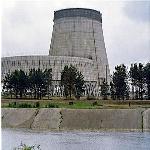April 23, 2011

Photo: AP
Reactor No. 4 of the Chernobyl nuclear power plant stands encased in lead and concrete following the April 1986 accident, which released a cloud of radiation that circled the world in Pripyat, 1988 (file photo)
The accident at the Chernobyl nuclear plant did much more than change the lives of hundred thousands of affected people. It also contributed greatly to Western science. Physicists and medical professionals learned a great deal from the Chernobyl disaster.
Many people abroad learned about the Chernobyl nuclear plant's explosion well before the population of the Soviet Union. However, Western scientists had little access to the Chernobyl site and medical data for a long time.
In 1991, Alexander Sich, an American of Ukrainian descent, was the first - and for the long time the only - Western scientist who worked in the Chernobyl zone, together with Ukrainian and Russian researchers.
"The scientists were isolated because it was a zone and also people by that time have forgotten about the accident," noted Sich. "The people didn't have the right equipment."
As Sich recalls, his biggest shock came when he realized that the helicopters that were pouring the mixture of sand, boron and other elements on the burning reactor were missing their target - the exposed and super-hot, nuclear core. As a result, the reactor continued to burn for ten days, and the core went into a complete meltdown
"In fact because the core was never covered, the melted fuel actually 'froze' [solidified] itself after 9 days," added Sich.
The scientist says that while the complete core meltdown at Chernobyl was a major disaster, it fell far short of the catastrophe many nuclear power critics had feared, the so-called "China Syndrome." In that scenario, the exposed core of a nuclear reactor becomes so hot that the molten material literally burns its way down through the earth. Chernobyl, at least, proved that to be a myth.
However, as soon as the reasons for the explosion became clear, Western nuclear experts lost interest in Chernobyl.
"Once the West understood what caused the accident and this type of the reactors don't operate on the West, that kind of thing can never happen in the West," Sich added. "They were happy with that and they moved on."
But in the areas of medicine, pharmacology and emergency preparedness, the lessons from Chernobyl are still being learned. Alla Shapiro lived in Kyiv in 1986, and worked at the Kyiv Institute of Hematology and Blood Transfusion. She learned about the nuclear plant accident from her father.
"He called me to tell that he was listening to the Voice of America in the middle of the night, which was his usual thing to do to get the information, and the broadcast was that the nuclear plant in Pripyat - that there was a nuclear explosion," Shapiro recalled.
Later, Shapiro and other doctors were sent to the affected area, where she took blood samples from the population.
"The striking thing was how misinformed the population was at the village that was so close to the reactor," Shapiro added. "People didn't take any precautions. Nobody gave potassium iodide to children or adults in that area. And people were encouraged to use their products, collect mushrooms in the woods, and to burn leaves in the fall. So that the smoke, the mixture of radioactive isotopes, was in the air and people were breathing it."
Now, 25 years after the catastrophe, Shapiro works as a medical officer in the Office of Counter-Terrorism and Emergency Coordination, part of the Food and Drug Administration's Center for Drug Evaluation and Research. Her job is to make America ready for similar accidents, which involve radiation, or for the biological, chemical or nuclear terrorist attacks.
"The main [thing] is to have [a] high level of preparedness," Shapiro explained. "And the preparedness would include training the physicians and medical personal and informing the population in timely manner. With the first signs of radiation exposure, people have to go into shelters and then [comes] evacuation.? And in case of radioactive iodine, it is mandatory that people have to receive potassium iodide."
Back in the Soviet Union, Shapiro recalls information was concealed not only from the population, but from medical professionals as well.
"[A] Librarian told me that they were forced to take all the literature with the word 'radiation' and put it in [an] archive," Shapiro said.
The Chernobyl disaster provided the field of medicine with some other valuable lessons as well.
"There are two big areas where eyes opened for the physicians on both sides of the World," Shapiro noted. "That radiation burns really attributed to prognosis and outcome of the patients with acute radiation poisoning, that radiation burns really kill patients, if they are extensive - even for the patients who underwent bone marrow transplant. Bone marrow transplant can't save [all] patients. So, selection of the patients for bone marrow transplant is really crucial."
In the United States, the drugs for preventive treatment and alleviation of the effects of radiation poisoning are being developed. Shapiro and her colleagues at FDA collaborate with pharmaceutical companies and academic institutions on that task.
Any technological disaster that takes human lives is a tragedy. But it can also teach lessons for the future if the information is shared and made accessible to experts all over the World.